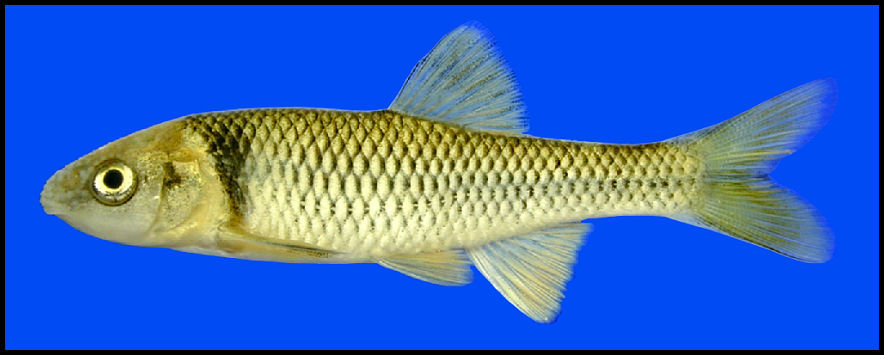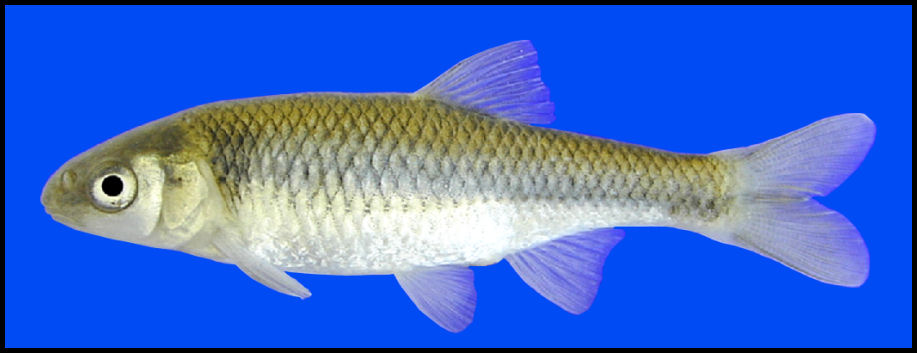|
Pictures by Chad Thomas, Texas State University |
||
|
Cyprinella proserpina proserpine shiner
Type Locality Devils River, Texas (Girard 1957).
Etymology/Derivation of Scientific Name Cyprinella – small carp, i.e., cyprinid; proserpina – latinized form of Persephone, queen of the infernal regions, possibly referring to the type locality of the Devils River (Scharpf 2005).
Synonymy Moniana proserpina Girard, 1857:200 (description; Devils River, Texas; position priority over M. aurata). Moniana aurata Girard, 1857:200 (brief description, following M. proserpina; “from Piedra Painte, New Mexico” [state presumably in error; the correct locality believed to be Pinto Creek, an intermittent tributary to the Rio Grande in northern Kinney County, Texas] (Hubbs and Miller 1978). Cyprinella proserpina Jordan 1878:421. Notropis proserpina Jordan 1885:125. Notropis proserpinus Hubbs and Miller 1978:589.
Characters Maximum size: 75 mm (2.95 in) TL (Page and Burr 1991).
Coloration: Dusky olive to blue back and side. Breeding male with white-edged orange fins, brassy yellow head, blue-black bar on side behind head (Page and Burr 1991). Distinct black median stripe from chin to isthmus; dark bar above pectoral fin base; interradial membranes of dorsal fin with melanophores which are weak or lacking in young and females (Hubbs et al. 1991).
Counts: Pharyngeal teeth 0,4-4,0; or pharyngeal teeth in 2 rows, 1 or 2,4-4,2 or 1. 34-36 lateral line scales; 8 anal fin soft rays; 13 pectoral fin soft rays (Hubbs and Miller 1978; Page and Burr 1991); fewer than 10 soft rays on dorsal fin (Hubbs et al. 1991).
Mouth position: Slightly subterminal (Page and Burr 1991; Bonner et al. 2008).
Body shape: Fairly deep body and compressed (Page and Burr 1991)
Morphology: Tubercles on head of dominant male larger on snout than on occiput; dorsal fin less triangular, last ray of dorsal fin about one-half the length of the longest; first obvious dorsal fin ray a thin splint, closely attached to the following well developed but unbranched ray, especially at tip; lower lip thin, without a fleshy lobe; lateral line usually not decurved, either straight or with a broad arch; premaxillaries protractile; upper lip separated from skin of snout by a deep groove continuous across the midline (Hubbs 1954; Hubbs et al. 1991). Intestine short, forming a simple S-shaped loop (Hubbs et al. 1991).
Distribution (Native and Introduced) U.S. distribution: Found only in Texas.
Texas distribution: Limited range includes Devils and lower Pecos rivers, Las Moras, Pinto, and San Felipe creeks (Harrell 1978; Hubbs and Miller 1978; Matthews 1980; Hubbs et al. 1991; Rhodes and Hubbs 1992), and Independence Creek (Bonner et al. 2005) in western Texas.
[Additional literature noting collection of this species from Texas locations includes, but is not limited to the following: Lytle (1972); Garrett et al. (1992); Linam and Kleinsasser (1996).]
Abundance/Conservation status (Federal, State, Non-governmental organizations) Vulnerable in United States; listed as critically imperiled and threatened in Mexico (Scharpf 2005). Species was listed as threatened by Texas Parks and Wildlife Department, July 18, 1977 (Bonner et al. 2008). Second most abundant minnow in Devil’s River, Texas (Harrell 1978; Matthews 1980); common (11%) in Independence Creek, Texas (Bonner et al. 2005; Bonner et al. 2008). Due to insufficient data regarding status of this species (Edwards et al. 2002), conservation programs have not been initiated (Bonner et al. 2008). Bonner et al. (2008) stated that future conservation efforts should include quantification of life history information, population monitoring, and maintenance of riverine habitat connectivity and natural flow regime.
Habitat Associations Macrohabitat: Associated with spring-fed tributaries (Harrell 1978; Bonner et al. 2005); spring-runs (Hubbs 1995).
Mesohabitat: In clear streams, occupies habitats varying from pools to swift channels and riffles (Matthews 1980). Spring influenced rocky runs and pool habitats (Hubbs 1995; Edwards et al. 2004). Species is adapted to flood-prone environments (Harrell 1978; Watson 2006); in the Devils River, Texas prior to flooding, this species is primarily a channel or near-channel inhabitant; post-flooding, proserpine shiners gained bio-mass riverwide, shifting toward intermediate-type habitats between channels and pools (Harrell 1978). Intolerant of lentic conditions resulting from reservoir construction (Williams et al. 1985; Bonner et al. 2008). In Independence Creek, Texas, estimated mean (± SE) current velocity is 32.0 (± 0.60) cm/s-1 for this species (T. Bonner, unpublished data in Leavy 2004); it inhabits runs and flowing pools, and measured 60.8 (± 2.93) cm/s-1 in mean absolute swimming speed (Leavy 2004).
Biology Spawning season: Late spring to early fall, in the Devils River, Texas (Valdes and Winemiller 1997; Bonner et al. 2008).
Spawning habitat: May be a crevice spawner; however this is unknown (Johnston 1999; Bonner et al. 2008).
Spawning Behavior: No information at this time.
Fecundity: No information at this time.
Age at maturation: No information at this time.
Migration: No information at this time.
Growth and Population structure: No information at this time.
Longevity: No information at this time.
Food habits: Benthic invertivore feeding mainly on various types of aquatic insects (Harrell 1978; Watson 2006; Bonner et al. 2008).
Phylogeny and morphologically similar fishes C. proserpina is similar to both the red shiner (C. lutrensis) and plateau shiner (C. lepida), but the latter two species lack a black stripe on chin and throat (may have dusky stripe on chin); have mouth position that is terminal, and red or orange fins (Page and Burr 1991). In Texas, C. proserpina occupies spring runs, and C. lutrensis occupies downstream areas (Rhodes and Hubbs 1992; Hubbs 1995).
Host Records No information at this time.
Commercial or Environmental Importance This species is a desert fish with small geographic range, and is threatened by decreased spring flows, habitat loss and fragmentation, and alteration of flow regimes (Bonner et al. 2008). Extirpated from areas of the Pecos and Devils rivers after inundation following completion of Amistad Reservoir (Hubbs and Echelle 1972; Williams et al. 1985; Bonner et al. 2008). Abundance of this species declined due to increased stream turbidity resulting from overgrazing (Hubbs and Echelle 1972; Bonner et al. 2008). Apparently extirpated and replaced by the red shiner (C. lutrensis) in Las Moras and Pinto Creeks, Texas; replacement likely due to declines in water quality and quantity (Edwards et al. 2004).
Species successfully used in experimental stream units; reported to have produced larvae while inhabiting stream (Matthews et al. 2006).
References
Bonner, T. H., C. Thomas, C. S. Williams & J. P. Karges. 2005. Temporal assessment of a West Texas stream fish assemblage. Southwest. Nat. 50:74-78.
Bonner, T.H., J.M. Watson, and C.S. Williams. 2008. Threatened fishes of the world: Cyprinella proserpina Girard, 1857 (Cyprinidae). Environmental Biology of Fishes 81:365-366.
Edwards, R. J., G. P. Garrett & E. Marsh-Matthews. 2002. Conservation and status of the fish communities inhabiting the Rio Conchos basin and middle Rio Grande, Mexico and U.S.A. Rev. Fish Bio. & Fish. 12:119-132.
Edwards, R.J., G.P. Garrett, and N.L. Allan. 2004. Aquifer-dependent fishes of the Edwards Plateau region. pp. 253-268 in: Mace, R.E., E.S. Angle, and W.F. Mullican, III, eds. Aquifers of the Edwards Plateau. Texas Water Development Board. 360 pp.
Garrett, G.P., R.J. Edwards, and A.H. Price. 1992. Distribution and status of the Devils River minnow, Dionda dioboli. The Southwestern Naturalist 37(3):259-267.
Girard, C. 1857. Researches upon the cyprinoid fishes inhabiting the fresh waters of the United States of America, west of the Mississippi Valley, from specimens in the Museum of the Smithsonian Institution. Proc. Acad. Nat. Sci. Phila. 8(1856):165-218.
Harrell, H. L. 1978. Response of the Devil’s River (Texas) fish community to flooding. Copeia 1978:60-68.
Hubbs, C. 1954. Corrected distributional records for Texas fresh-water fishes. Texas Journal of Science 1954(3):277-291.
Hubbs, C. 1995. Perspectives: springs and spring runs as unique aquatic systems. Copeia 1995(4):989-991.
Hubbs, C. L. & A. A. Echelle. 1972. Endangered non-game fishes of the upper Rio Grande basin. Pp. 147-167. In: Symposium on endangered vertebrates of Southwestern United States. New Mexico Game and Fish Department, p 345. Hubbs, C., R.J. Edwards, and G.P. Garrett. 1991. An annotated checklist of the freshwater fishes of Texas, with keys to identification of species. Texas Journal of Science, Supplement 43(4):1-56.
Hubbs, C., R.J. Edwards, and G.P. Garrett. 2008. An annotated checklist of the freshwater fishes of Texas, with keys to identification of species. Texas Journal of Science, Supplement, 2nd edition 43(4):1-87.
Hubbs, C.L., and R.R. Miller. 1978. Notropis panarcys, n. sp., and N. proserpinus, cyprinid fishes of subgenus Cyprinella, each inhabiting a discrete section of the Rio Grande complex. Copeia 1978:582-592.
Johnston, C. E. 1999. The relationship of spawning mode to conservation of North American minnows (Cyprinidae). Environ. Bio. Fishes 55:21-30.
Jordan, D.S. 1878. Distribution of freshwater fishes of the United States. Ann. N.Y. Acad. Sci. 1:92-120.
Jordan, D. S. 1885. Identification of the species of Cyprinidae and Catostomidae, described by Dr. Charles Girard, in the proceedings of the Academy of Natural Sciences of Philadelphia for 1856. Proceedings of the United States National Museum 8:118-127.
Leavy, T.R. 2004. Relationships among swimming ability, habitat use, and morphology of freshwater fishes from Texas and Louisiana. Master of Science Thesis, Texas State University – San Marcos. 40 pp.
Linam, G.W., and L.J. Kleinsasser. 1996. Relationship between fishes and water quality in the Pecos River, Texas. River Studies Report No. 9. Texas Parks and Wildlife Department, Austin. 10 pp. Lytle, G.L. 1972. Cyprinid fishes of the subgenus Cyprinella of Notropis from southeast Texas, U.S.A., and Northeast Mexico. M.S. Thesis, Arizona State University. 75 pp.
Matthews, W. J. 1980. Notropis proserpinus (Girard), Proserpine shiner. p. 299. In: D. S. Lee, C. R. Gilbert, C. H. Hocutt, R. E. Jenkins, D. E. McAllister & J. R. Stauffer, Jr. (eds.), Atlas of North American freshwater fishes, North Carolina State Museum of Natural History, Raleigh, 854 pp.
Matthews, W.J., K.B. Gido, G.P. Garrett, F.P. Gelwick, J. Stewart, and J. Schaefer. 2006. Modular experimental riffle-pool stream system. Trans. Amer. Fish. Soc. 135(6):1559-1566.
Page, L. M. & B. M. Burr. 1991. A field guide to freshwater fishes of North America north of Mexico. Houghton Mifflin Company, Boston, Massachusetts. 432 pp.
Rhodes, K. & C. Hubbs. 1992. Recovery of Pecos River fishes from a red tide fish kill. Southwest. Nat. 32:178-187.
Robertson M. S. & K. O. Winemiller. 2003. Habitat associations of fishes in the Devil’s River, Texas. J. Freshwater Eco. 18:115-127.
Scharpf, C. 2005. Annotated checklist of North American freshwater fishes including subspecies and undescribed forms, Part 1: Petromyzontidae through Cyprinidae. American Currents, Special Publication 31(4):1-44.
Valdes, N.E. & K.O. Winemiller. 1997. Structure and habitat associations of Devils River fish assemblages. Southwest. Nat. 42:265-278.
Watson, J. M. 2006. Patterns and habitat association of a desert spring fish assemblage and responses to a large-scale flood. M.S. Thesis, Texas State University, San Marcos. 35 pp.
Williams, J. E., Bowman, D. B., Brooks, J. E., Echelle, A. A., Edwards, R. J., Hedrickson, D. A. & Landye, J. J. 1985. Endangered aquatic ecosystems in North American deserts with a list of vanishing fishes of the region. J. Az-Nev Acad. Sci. 20:1-62. |
||
|
|
||

